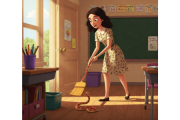Insects and wildlife were all around us, of course, though I can’t say that we ever saw lions, wildebeest, giraffes, zebras, or hippos, nearby. We could hear hyenas sometimes, cackling in the distances, but that was about it.
Smaller creatures, and some not so small, were still around us, though. Cicadas chirped away, and fireflies provided light displays at nighttime. Harmless gecko lizards ran across our walls, even indoors, losing their tails, in moments of danger. It fascinated us that their tails would grow again over time. Mosquitoes were a fact of life, so mosquito nets were suspended from a hook in the ceiling, above our beds. The nets were tied up high during the day but spread out to cover the beds at night.
Crocodiles lived in the rivers, as did small invisible parasites which spent part of their life cycle in snails, would cause the debilitating sickness bilharzia in people who bathed in, or drank from, these waters; even vegetables and salads bought in stores had to be rewashed in clean water, to ensure that they were free of contamination. The only known cure for bilharzia at that time was for the sufferer to undergo a series of twenty-four very painful injections into the stomach.
Insects and reptiles were numerous, some of them fascinating, like the large praying mantises and stick insects, which perched on twigs and blades of grass; or the chameleon, which changed colour according to its background. This lizard-like creature had independently bulging eyes, which could see almost 360 degrees. It would keep its long thin tongue hidden, curled up tightly in its mouth until a tasty morsel such as a fly was spotted. Thereupon, that sticky tongue was suddenly unleashed to stretch several inches, grabbing its prey with infallible accuracy.
Maggot flies would lurk in any laundry put outside to dry. Unless everything fabric-like that touched our skin, was thoroughly ironed (including sheets, underwear, towels, and socks), maggots would emerge in boil-like eruptions just beneath the surface of our skin. We would have to cover these outbreaks with Vaseline, and a Band Aid, to deprive the maggots of oxygen.
Since the soil everywhere was bright red, and because we children played outside in the dirt, often making mud pies, our clothing was frequently stained. We didn’t have a washing machine, nor a dryer in those days. Not even a wringer. Doing laundry was a daily chore, involving several steps: soak the items overnight in a bathtub of soapy water; next morning, stomp up and down in that same water, swirling the items to remove lingering dirt; rinse; wring out by hand; hang on the washing line outside; then iron, with a hot iron, every square inch of every single item.
I hated snakes. I can never forget the very first day we arrived in Darwendale, when the residents were abuzz with the news that the local policeman had just killed an enormous snake, which was now on display at the gas station, for all to see. So down we went, too. Just about the entire village had turned out to see the corpse, and to congratulate the heroic policeman. He had shot a bullet into the head of a 15ft.-long python which had been terrorizing local villagers for several weeks, eating their dogs and even a small African child, so it was said. Never have I forgotten that snake. The body was as broad as a man’s arm, and with a bulge in the middle, where the python had recently devoured a small animal of some kind. I just could not get over the size of it. I was immediately traumatized, even though a local African had tried to add some humour to the scene by placing a cigarette stub in the snake’s mouth.





Rachel3 years ago
Hi grandma I like it 😊